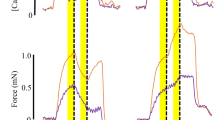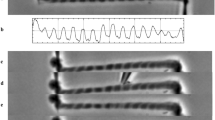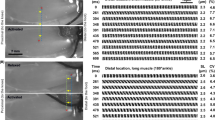Abstract
The relationship between the diffraction intensity change of the first order line and tension development was examined in mechanically skinned single fibers from the dorsal head of the semitendinosus of frogs. Passive stretch of the fibers resulted in an increase in intensity over the range of sarcomere lengths from 2.5 to 3.6 μm, indicating that the intensity is a function of sarcomere length. Activation of skinned fibers caused a decrease in the intensity, at all sarcomere lengths, where the thick and thin filaments overlapped. The magnitude of the intensity decrease and that of the tension development depended on the Ca2+ concentration in the medium. The drop of intensity-pCa and the tension-pCa curves showed a similarly steep S-shape within a range of 0.5 pCa unit, although the intensity-pCa curve shifted to the left; the pCa for 50% decrease in light signal was 6.48 and that for 50% tension development was 6.40. Caffeine (25 mM) added to the medium produced a decrease in the intensity of skinned fibers with the simultaneous development of tension, thereby indicating that caffeine induces a release of Ca2+ from the sarcoplasmic reticulum and disorder in the filaments ensues. Changes in diffraction intensity with electrical stimulation to the intact single fiber were similar, although a more striking summation was observed in the optical response, as compared to the tension development. These results suggest that tension development upon stimulation can be monitored by assessing the magnitude of diffraction intensity decrease in the first order line, except for some shift in the short fiber.
Similar content being viewed by others
References
Baskin RJ, Roos KP, Yeh Y (1979) Light diffraction study of single skeletal muscle fibers. Biophys J 28:45–64
Baskin RJ, Lieber RI, Oba T, Yeh Y (1981) Intensity of light diffraction from striated muscle as a function of incident angle. Biophys J 36:759–773
Endo M (1977) Calcium release from the sarcoplasmic reticulum. Physiol Rev 57:71–108
Fujime S (1975) Optical diffraction study of muscle fibres. Biochim Biophys Acta 379:227–238
Hellam DC, Podolsky RJ (1969) Force measurements in skinned muscle fibres. J Physiol (Lond) 200:807–819
Hwang JC, Leung AF, Cheung YM (1981) Estimation of changes in single muscle fibre diameter in different solutions by diffraction studies. Pflügers Arch 390:70–72
Julian FJ (1971) The effect of calcium on the force-velocity relation of briefly glycerinated frog muscle fibres. J Physiol (Lond) 218:117–145
Julian FJ, Moss RL (1980) Sarcomere length-tension relations of frog skinned muscle fibres at lengths above the optimum. J Physiol (Lond) 304:529–539
Oba T, Baskin RJ, Lieber RL (1981) Light diffraction studies of active muscle fibers as a function of sarcomere length. J Muscle Res Cell Motil 2:215–224
Oba T, Hotta K (1983) Relationship between light diffraction intensity and tension development in frog skeletal muscle. Experientia 39:58–59
Paolini PJ, Roos KP, Baskin RJ (1977) Light diffraction studies of sarcomere dynamics in single skeletal muscle fibers. Biophys J 20:221–232
Ranvier L (1874) Du spectre produit par les muscles striés. Arch de Phydiol Norm Pathol 6:775–780
Roos KP, Baskin RJ, Lieber RL, Clin JW, Paolini PJ (1980) Digital data acquisition and analysis of striated muscle diffraction patterns with a direct memory access microprocessor system. Rev Sci Instrum 51:762–767
Rüdel R, Zite-Ferenczy F (1979) Interpretation of light diffraction by cross-striated muscle as Bragg reflexion of light by the lattice of contractile proteins. J Physiol (Lond) 290:317–330
Rüdel R, Zite-Ferenczy F (1980) Efficiency of light diffraction by cross striated muscle fibers under stretch and during isometric contraction. Biophys J 30:507–516
Sandow A (1936) Diffraction patterns of the frog sartorius and sarcomere behaviour under stretch. J Cell Comp Physiol 9:37–54
Ter Keurs HEDJ, Iwazumi T, Pollack GH (1978) The sarcomere lengthtension relation in skeletal muscle. J Gen Physiol 72:565–592
Umazume Y, Yoshioka T (1980) In: Ebashi S, Maruyama K, Endo M (eds) Muscle contraction: Its regulatory mechanisms Jpn Sci Soc Press, Tokyo, Springer, Berlin Heidelberg New York, pp 475–481
Yeh Y, Baskin RJ, Lieber RL, Roos KP (1980) Theory of light diffraction by single skeletal muscle fibers. Biophys J 29:509–522
Zite-Ferency F, Rüdel R (1978) A diffractometer using a lateral effect photodiode for the rapid determination of sarcomere length changes in cross-striated muscle. Pflügers Arch 374:97–100
Author information
Authors and Affiliations
Rights and permissions
About this article
Cite this article
Oba, T., Hotta, K. The effect of changing free Ca2+ on light diffraction intensity and correlation with tension development in skinned fibers of frog skeletal muscle. Pflugers Arch. 397, 243–247 (1983). https://doi.org/10.1007/BF00584365
Received:
Accepted:
Issue Date:
DOI: https://doi.org/10.1007/BF00584365




